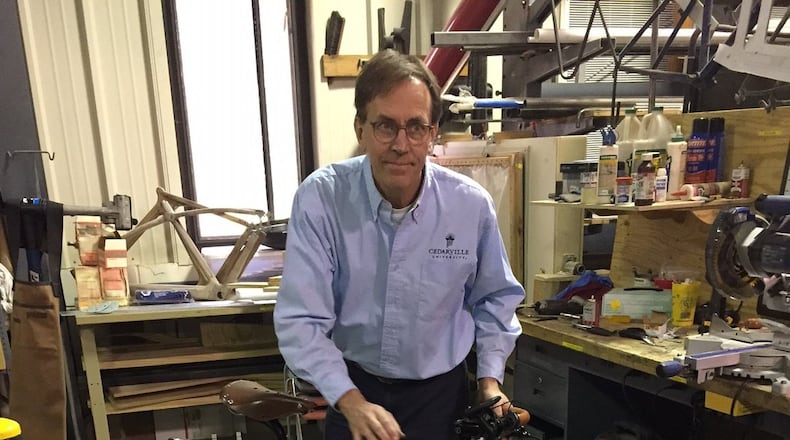He said he first became aware of the e-bike on a bicycling tour with his family in Germany in 2011. “As we pedaled the bike path along the Mosel River we were having our doors blown off by octogenarians with big smiles on their faces,” he said.
Since then Kinsinger has developed a passion for designing wooden bikes and thought that an e-bike might make a challenging capstone project for his senior engineering students.
“Wooden bikes are really unique and out-of-the box. I am all about real world experiences and problems that do not have ‘right answers’ in the back of a book,” said Kinsinger.
The project was later expanded to include marketing and industrial and innovative design students with the idea that it would help to more accurately simulate a real world experience.
Trayton Ojala, an industrial designer and project specialist at Cedarville’s International Center for Creativity (ICC) said this was a challenging project for his students because they had to learn to work with people that do not think like them.
Kinsinger agreed that projects such as these are important because they force students to consider how their project will work or be useful in the real world. “Engineers are notorious for designing things that function well but do not have the necessary market appeal in terms of aesthetics and pricing to make it a money-making endeavor,” he said.
He said he found it particularly gratifying watching students wrangle over details such as style and function.
Finally, Cedarville Associate Marketing Professor, Alex Camacho and his students came into the picture. Camacho and his students worked on market analysis, operations and marketing costs and all the details that would make the hard work of the designers and engineers pay off.
He said that they discovered four separate target markets including: millennials - who are very successful in their careers, and live in large cities that are looking to have a sustainable convenient means of transportation that is unique and reflects their individuality; Seniors 55 and over who enjoy biking but do not want to deal with the pain of hills and mountains, high-end resorts and avid bikers - who are looking for one more bike that reflects their identity and passion for bikes.
Cedarville engineering student, True Baldwin said it was really great to see everything finally come together and he believes that he got more out of the collaboration than he would if he had just worked on the project as and engineering student. “For me, I know I was excited to join the Industrial Design students in partnering to sketch up the first ideas of our bike. I think collaboration was a big influence on me joining this senior project. This was a large-scale project that we saw through all the way from an idea to riding it ourselves.”
About the Author
